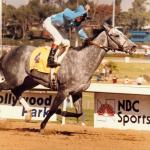
Golden Tempo Goes Last-to-First to Capture Lecomte Stakes at Fair Grounds

Racetrack Television Network is the industry leader in providing high-definition video broadcasts of live horse racing from around the world to consumers in their homes and on their mobile devices. It has been an innovator in this field since launching as an offshoot of Roberts Communications Network, which introduced simulcast signal racing to the sport in the 1980s.
Todd Roberts, CEO of Racetrack Television Network, recently took a few minutes to chat about his company’s services and how it’s meeting the needs of racetracks, horseplayers, and fans as viewing habits shift to mobile.
Roberts also reflects on his lifelong love of the sport, which started as a child watching his father, sports announcer and broadcasting innovator Tommy Roberts, call the races.
What is RTN? What services does it provide?
The best way to understand RTN is that it’s the every-game package, league package that other sports have – it’s the NFL Sunday Ticket for horse racing, it’s like NHL Center Ice, NBA League Pass, and MLB Extra Innings. We provide full-card coverage of every track in a one-stop shopping environment that’s subscription-based and can also be ad-supported.
How did you become involved with RTN?
We started RTN in 2002. It used to be TRN, which a bunch of track operators owned, and that went out of business but the people loved the concept because it was full card. It’s not a linear channel such as TVG, which does a great job, but it’s just hard to satisfy racing fans by cutting back and forth between tracks and picking which tracks you’re going to show, so they loved the format because it’s like they were sitting in a simulcast outlet.
How has your business evolved over the years as fans change their viewing habits?
It used to be a private direct-to-home satellite network – which in itself, back in the day of 2002, was a tremendous innovation to be able to basically bypass any of the traditional pay-TV distributors and go directly to a consumer’s home, because it’s a niche product so people would pay to get racing, especially back then, in their home. And then it evolved in 2011 where we ended the private direct-to-home network and made a deal with DISH Network – we actually built our own 80 channels that coincide with DISH.
What’s innovative about that is, it was the first time ever that someone was able to make the brick-and-mortar simulcast appear in a consumer’s home without any retransmission, any further delay, and any loss of picture quality. So it was actually simultaneous distribution to both brick and mortar facilities, which Roberts Communications controls, and to RTN which we control in partnership with DISH. So that was a huge breakthrough.
There’s a plus and a minus with that model. The plus is that anyone who wants to watch racing can get DISH Network and install it and there’s no boundaries. It’s not like you’re on a cable company and they only have certain regions of the country that they cover. So we have nationwide coverage. The drawback was that as we tried to get on other pay-TV platforms, nobody had the capacity to give you an 80-channel package. It’s by far the largest sports package offering in the world.
You look at NFL, they basically run one day a week with maybe 10 channels. Baseball is bigger, but not that big, hockey and basketball – they’re all in the same boat. They don’t have seven-day-a-week coverage, noon to midnight, 365 days a year, and we do.
As it evolved, we quickly jumped into online and mobile distribution as well, which again took away all of the boundaries and borders of traditional pay-TV distribution and got it to people in another fashion.

What do you offer with your online/mobile service?
We deliver to smartphones, tablets, and desktop PCs. First of all, we pride ourselves in having the largest menu of racetrack simulcasts of anybody in the world. Not very many brick-and-mortar locations carry the full menu of simulcasts, and we go beyond that in offering round-the-clock racing. There’s a lot of international racing on there.
We offer packages that we worked really carefully over the years to try to develop. We offer replay-only packages, we offer live streaming and replay packages, and then we break it down by breed, so you can buy harness and, of course, Thoroughbred, and there’s a Quarter Horse package. And then we recently started offering individual track packages to incent tracks to stop the practice of free streaming on their websites and other areas where they can’t monetize and they can’t control piracy. So we upgrade them to HD (high definition), we put free replays on their websites, and they promote RTN and encourage people to go buy HD broadcast of their track from the RTN website and share the revenue.
The move to HD in racing has been very beneficial to tracks and fans.
It’s a perfect solution because so many tracks are fearful that they’re going to make someone mad by ending a free stream in SD (standard definition) on their website. People will gladly pay $5 to get that stream and the archives in HD. You see that revolution throughout the sports world. People want sports packages and they want HD, and you can get all of these archives – it’s an incredible value.
The problem is that there are too many marketing directors who don’t understand content distribution, and so they think, ‘Oh, I’ll just put our stream on our website and that’s a great way to promote our sport – somebody will see it and want to bet on it, or put it on YouTube or on social media.’ And it’s absolutely the worst possible thing you could do. We always tell people it’s like this: you go to San Francisco and stand at Ghirardelli Square and see all of the candy shops handing out samples. And that’s meant to encourage people to go inside and buy a box of chocolates. Racing stands up front and gives away the box of chocolates that they’re trying to sell inside the store whenever they try to give away free video streams. And they don’t understand that there’s pirates all over the world that are bookmaking, they pay the tracks nothing, and they encourage their bettors to view the free track streams, and the tracks pay for it.
So the RTN monetization of content has been a long and slow and expensive process, but people are starting to get it. We’re also starting to add other features into RTN, such as carrying sports handicapping. We have a great network on RTN called VSiN, which is based in Vegas, and they have tremendous distribution. As racing and sports start to come together throughout the world through sports betting, people will get access to those channels as well for free, it’s part of their subscription.
How do you see your business growing in the coming years? What new technologies are you excited about?
One of the things we work very hard at is removing latency in the broadcasts. Recently through our sister company Roberts Communications we upgraded our streaming platform to the lowest latency that we could produce, so basically from source to somebody’s device, it’s about four seconds. Which is pretty darn good – a lot of people claim lower but they’re measuring from different points. The other thing that we do is, with the streams that we use that Roberts transmits, we don’t use the Internet until the very last moment to deliver to the consumer. People say, ‘What’s the trick to Internet distribution?’ The trick is to keep the stream off of the Internet as long as possible.
We’re really proud of the latency and the picture quality, and we’re about to go through a massive upgrade of picture quality again, mainly driven by Roberts Communications, but we buy the feeds from Roberts and we’re about to see a giant jump not only in the amount of tracks that are HD but also the quality of the HD is going to be improved. So we want RTN to be the one-stop shop but also the known source for the best video, the most video, and the most different ways to watch video. It’s supposed to be a league-like product offering.
What drew you into horse racing? How did you become a fan?
My dad introduced me. He was a sportscaster back in Philadelphia and did play-by-play for the Philadelphia Eagles and the Philadelphia Warriors before they were the 76ers. He came up with a lot of well-known national sportscasters, the era of Jim McKay, Jack Whitaker, and Chris Schenkel. They evolved into network broadcasting and he moved into horse racing. So I started going to racetracks when I was 8 years old, with him.
He did the first national television broadcast on a weekly basis from Hialeah Park and Gulfstream Park back in the late 1950s and 1960s, and he also had a radio network for years in the Philadelphia/New Jersey market – mainly Monmouth Park, Atlantic City Race Course, and Philadelphia Park, now Parx Racing. And so, I would sit in the broadcast booth with him from the time I was 8 years old and watch him do the broadcast on the radio, where he would do the feature race of the day for whatever track was running. He had upwards of 30-40 radio stations that bought the feed from him and promote racing. Back then we would get in the car and start to drive home and turn on the radio and we would be listening to his broadcast.
That was my introduction. Back in those days he would have to sneak me up in the freight elevator and get permission from the state stewards to sit in the booth with him. I was hooked.

What is your all-time favorite race?
There’s no question that it’s Secretariat’s win in the 1973 Belmont Stakes. My dad actually did the call of the Triple Crown that year for the Mutual Radio Network. He called the Belmont Stakes from the dining room at Belmont Park because they didn’t have enough space for him. We had his broadcast on our phone system for years for when people would go on hold, and they’d ask us to hang up so they could finish listening to his call. He called it as a 20-length victory because from his vantage point, it was too hard to tell. But it was probably one of the best race calls I’ve ever heard, one of the most exciting, he was a great racecaller. That race, I can listen to it every day.
What is your all-time favorite racehorse?
Secretariat, no question about it.
What is your favorite racetrack to visit?
In the old days, it was Hialeah. That was just a magical place. Nowadays, I’d probably have to say Santa Anita Park. Keeneland is very, very special, and Del Mar’s really fun. I’d say those three.
Are you a horseplayer? If so, what are your go-to wagers?
I play when I’m at the track. I used to play in race books earlier in my career but don’t have time now. I’m an exacta box wagerer, that’s my go-to bet.